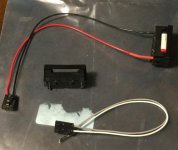Zippy Zapp
Experienced Member
Hi,
I recently picked up a Tower G3 beige that was classified as working and no problems. It works, except the drive is dead and the battery was corroded and it looks like it corroded part of the case frame in a 3 inch diameter with some nasty rust. Very irritating. The battery holder literally disintegrated when I attempted to remove the spewed battery.
No problem, ordered one of these and figured I would desolder the old one and install a new one of these:
https://www.digikey.com/short/3zh47w
The positive side came out easy enough. But the negative side refused and the pad broke in the process.
What do people do in these cases? I'll show you my solution but maybe there is a better way?
I solder blobbed both sides of the negative side and checked for continuity to the negative vias and capacitor sides and it seemed fine so that was a relief. I then took the battery holder and a I2C 4 pin cable and removed two wires, red and black from one end of the connecter and the crimp side slides perfectly over the pins in the battery holder. A little bit of solder and some heat shrink and it is sound.
I used some header pins to solder into the positive side of the motherboard battery pads and a wire from a header pin to the negative battery pad/blob. A little velcro and it seems to do the trick.
What do you think?

I recently picked up a Tower G3 beige that was classified as working and no problems. It works, except the drive is dead and the battery was corroded and it looks like it corroded part of the case frame in a 3 inch diameter with some nasty rust. Very irritating. The battery holder literally disintegrated when I attempted to remove the spewed battery.
No problem, ordered one of these and figured I would desolder the old one and install a new one of these:
https://www.digikey.com/short/3zh47w
The positive side came out easy enough. But the negative side refused and the pad broke in the process.
What do people do in these cases? I'll show you my solution but maybe there is a better way?
I solder blobbed both sides of the negative side and checked for continuity to the negative vias and capacitor sides and it seemed fine so that was a relief. I then took the battery holder and a I2C 4 pin cable and removed two wires, red and black from one end of the connecter and the crimp side slides perfectly over the pins in the battery holder. A little bit of solder and some heat shrink and it is sound.
I used some header pins to solder into the positive side of the motherboard battery pads and a wire from a header pin to the negative battery pad/blob. A little velcro and it seems to do the trick.
What do you think?

